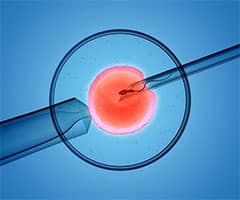 The process and consequence of fertilizing is called fertilization . This verb , in a biological sense, refers to the union of a male reproductive cell with a female reproductive cell to give rise to a new being .
The process and consequence of fertilizing is called fertilization . This verb , in a biological sense, refers to the union of a male reproductive cell with a female reproductive cell to give rise to a new being .
These sex cells are called gametes . When the male gamete fuses with the female gamete through sexual reproduction , fertilization occurs, a process that involves the creation of another individual, whose genome is derived from the genes of its parents.
It can be said, therefore, that fertilization involves the creation of a new individual from the genetic combination of its parents (a male specimen and a female specimen).
Fertilization begins when the sperm (male gamete) comes into contact with the egg (female gamete) and recognition occurs between the two. Then the sperm enters the egg and an interaction begins to develop that enables the fusion of the respective genetic materials. This is how the zygote is formed, which is the cell that results from the union of gametes.
Once fertilization has been completed, the zygote develops and goes through various stages: first it reaches the embryonic state, then it transforms into a fetus and finally, when it has achieved the necessary development, it is born as a new individual. In the case of human beings, nine months pass from fertilization to birth.
Natural fertilization in our species occurs when a man and a woman have a sexual relationship and the man ejaculates inside the woman's vagina, allowing his sperm to come into contact with the eggs. It is also possible to achieve reproduction through artificial fertilization with the help of laboratory techniques.
In 1979, the birth of the first girl to have been conceived through the application of an artificial fertilization technique called in vitro took place, a merit attributed to doctors Steptoe and Edwards . Before this historic moment in science, there were many years of tests that did not give the expected results.
The process required the extraction of an ovary , which was artificially fertilized. Since in the natural cycle only one egg can be obtained, the doctors took a long time between one test and another. In addition, the egg must have the appropriate maturity and genetic health for the fertilization of an embryo with a healthy structure, so that it can divide and then be implanted in the uterus .
 One of the milestones of in vitro fertilization occurred when doctors began using drugs to stimulate ovulation , so that in each cycle they could obtain more mature eggs. Thanks to this advance in the technique, it is possible to extract a greater number of embryos, closely study the evolution of each one and finally choose the best ones to implant in the uterus.
One of the milestones of in vitro fertilization occurred when doctors began using drugs to stimulate ovulation , so that in each cycle they could obtain more mature eggs. Thanks to this advance in the technique, it is possible to extract a greater number of embryos, closely study the evolution of each one and finally choose the best ones to implant in the uterus.
In vitro fertilization also improved when scientists began using drugs called gonadotropins , which prevent premature ovulation from occurring, that is, before the eggs are removed from the ovaries.
Thanks to having many embryos, in vitro fertilization allowed patients to receive a high number per implantation (in certain countries, up to seven at a time) and this increased the chances of pregnancy . But this did not always bring positive consequences, since one of the most common complications of this technique appeared: multiple pregnancy.
If the man in the couple has problems producing sperm normally, then it is possible to carry out fertilization using a technique known as ICSI , which consists of injecting the sperm into the cytoplasm of the oocyte.
